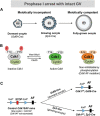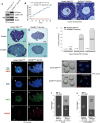Inhibitory phosphorylation of Cdk1 mediates prolonged prophase I arrest in female germ cells and is essential for female reproductive lifespan
- PMID: 27767095
- PMCID: PMC5099868
- DOI: 10.1038/cr.2016.119
Inhibitory phosphorylation of Cdk1 mediates prolonged prophase I arrest in female germ cells and is essential for female reproductive lifespan
Abstract
A unique feature of female germ cell development in mammals is their remarkably long arrest at the prophase of meiosis I, which lasts up to 50 years in humans. Both dormant and growing oocytes are arrested at prophase I and completely lack the ability to resume meiosis. Here, we show that the prolonged meiotic arrest of female germ cells is largely achieved via the inhibitory phosphorylation of Cdk1 (cyclin-dependent kinase 1). In two mouse models where we have introduced mutant Cdk1T14AY15F which cannot be inhibited by phosphorylation (Cdk1AF) in small meiotically incompetent oocytes, the prophase I arrest is interrupted, leading to a premature loss of female germ cells. We show that in growing oocytes, Cdk1AF leads to premature resumption of meiosis with condensed chromosomes and germinal vesicle breakdown followed by oocyte death, whereas in dormant oocytes, Cdk1AF leads to oocyte death directly, and both situations damage the ovarian reserve that maintains the female reproductive lifespan, which should be around 1 year in mice. Furthermore, interruption of the inhibitory phosphorylation of Cdk1 results in DNA damage, which is accompanied by induction of the Chk2 (checkpoint kinase 2)-p53/p63-dependent cell death pathway, which eventually causes global oocyte death. Together, our data demonstrate that the phosphorylation-mediated suppression of Cdk1 activity is one of the crucial factors that maintain the lengthy prophase arrest in mammalian female germ cells, which is essential for preserving the germ cell pool and reproductive lifespan in female mammals.
Figures





Similar articles
-
The switch from cAMP-independent to cAMP-dependent arrest of meiotic prophase is associated with coordinated GPR3 and CDK1 expression in mouse oocytes.Dev Biol. 2018 Feb 1;434(1):196-205. doi: 10.1016/j.ydbio.2017.12.014. Epub 2017 Dec 21. Dev Biol. 2018. PMID: 29274320
-
Prophase I arrest and progression to metaphase I in mouse oocytes: comparison of resumption of meiosis and recovery from G2-arrest in somatic cells.Mol Hum Reprod. 2010 Sep;16(9):654-64. doi: 10.1093/molehr/gaq034. Epub 2010 May 7. Mol Hum Reprod. 2010. PMID: 20453035 Free PMC article. Review.
-
Cdk1, but not Cdk2, is the sole Cdk that is essential and sufficient to drive resumption of meiosis in mouse oocytes.Hum Mol Genet. 2012 Jun 1;21(11):2476-84. doi: 10.1093/hmg/dds061. Epub 2012 Feb 24. Hum Mol Genet. 2012. PMID: 22367880
-
The regulation of maturation promoting factor during prophase I arrest and meiotic entry in mammalian oocytes.Mol Cell Endocrinol. 2014 Jan 25;382(1):480-487. doi: 10.1016/j.mce.2013.07.027. Epub 2013 Aug 3. Mol Cell Endocrinol. 2014. PMID: 23916417 Review.
-
Disrupting Cyclin Dependent Kinase 1 in Spermatocytes Causes Late Meiotic Arrest and Infertility in Mice.Biol Reprod. 2015 Dec;93(6):137. doi: 10.1095/biolreprod.115.134940. Epub 2015 Oct 21. Biol Reprod. 2015. PMID: 26490841 Free PMC article.
Cited by
-
Premature activation of Cdk1 leads to mitotic events in S phase and embryonic lethality.Oncogene. 2019 Feb;38(7):998-1018. doi: 10.1038/s41388-018-0464-0. Epub 2018 Sep 6. Oncogene. 2019. PMID: 30190546 Free PMC article.
-
Mysteries and unsolved problems of mammalian fertilization and related topics.Biol Reprod. 2022 Apr 26;106(4):644-675. doi: 10.1093/biolre/ioac037. Biol Reprod. 2022. PMID: 35292804 Free PMC article. Review.
-
Involvement of CaMKII in regulating the release of diplotene-arrested mouse oocytes by pAkt1 (Ser473).Cell Cycle. 2019 Nov;18(21):2986-2997. doi: 10.1080/15384101.2019.1666596. Epub 2019 Sep 18. Cell Cycle. 2019. PMID: 31530151 Free PMC article.
-
The diverging role of CDC14B: from mitotic exit in yeast to cell fate control in humans.EMBO J. 2023 Aug 15;42(16):e114364. doi: 10.15252/embj.2023114364. Epub 2023 Jul 26. EMBO J. 2023. PMID: 37493185 Free PMC article. Review.
-
SGK1 is essential for meiotic resumption in mammalian oocytes.Eur J Cell Biol. 2022 Apr;101(2):151210. doi: 10.1016/j.ejcb.2022.151210. Epub 2022 Feb 25. Eur J Cell Biol. 2022. PMID: 35240557 Free PMC article.
References
-
- McGee EA, Hsueh AJ. Initial and cyclic recruitment of ovarian follicles. Endocr Rev 2000; 21:200–214. - PubMed
-
- Adhikari D, Liu K. Molecular mechanisms underlying the activation of mammalian primordial follicles. Endocr Rev 2009; 30:438–464. - PubMed
-
- Eppig JJ, Viveiros MM, Bivens CM, De La Fuente R. Regulation of mammalian oocyte maturation. In: Leung PC, Adashi EY, eds. The Ovary. Academic Press: Amsterdam 2004:113–129.
MeSH terms
Substances
LinkOut - more resources
Full Text Sources
Other Literature Sources
Molecular Biology Databases
Research Materials
Miscellaneous

